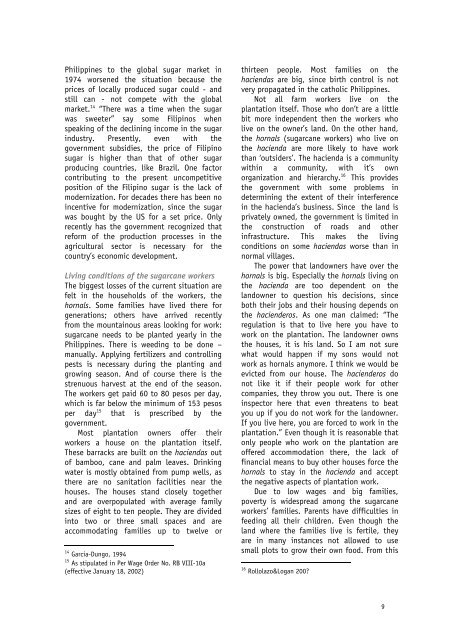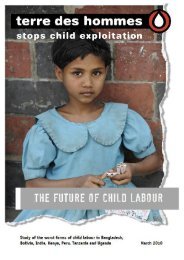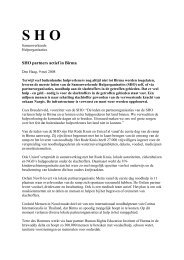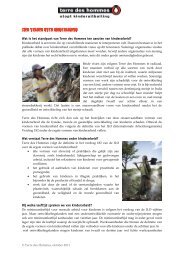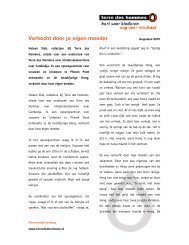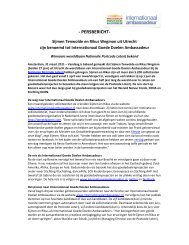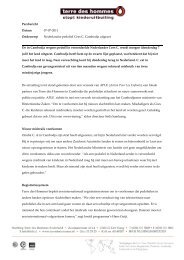SWEET HAZARDS - Terre des Hommes
SWEET HAZARDS - Terre des Hommes
SWEET HAZARDS - Terre des Hommes
Create successful ePaper yourself
Turn your PDF publications into a flip-book with our unique Google optimized e-Paper software.
Philippines to the global sugar market in1974 worsened the situation because theprices of locally produced sugar could - andstill can - not compete with the globalmarket. 14 “There was a time when the sugarwas sweeter” say some Filipinos whenspeaking of the declining income in the sugarindustry. Presently, even with thegovernment subsidies, the price of Filipinosugar is higher than that of other sugarproducing countries, like Brazil. One factorcontributing to the present uncompetitiveposition of the Filipino sugar is the lack ofmodernization. For deca<strong>des</strong> there has been noincentive for modernization, since the sugarwas bought by the US for a set price. Onlyrecently has the government recognized thatreform of the production processes in theagricultural sector is necessary for thecountry’s economic development.Living conditions of the sugarcane workersThe biggest losses of the current situation arefelt in the households of the workers, thehornals. Some families have lived there forgenerations; others have arrived recentlyfrom the mountainous areas looking for work:sugarcane needs to be planted yearly in thePhilippines. There is weeding to be done –manually. Applying fertilizers and controllingpests is necessary during the planting andgrowing season. And of course there is thestrenuous harvest at the end of the season.The workers get paid 60 to 80 pesos per day,which is far below the minimum of 153 pesosper day 15 that is prescribed by thegovernment.Most plantation owners offer theirworkers a house on the plantation itself.These barracks are built on the haciendas outof bamboo, cane and palm leaves. Drinkingwater is mostly obtained from pump wells, asthere are no sanitation facilities near thehouses. The houses stand closely togetherand are overpopulated with average familysizes of eight to ten people. They are dividedinto two or three small spaces and areaccommodating families up to twelve or14 Garcia-Dungo, 199415 As stipulated in Per Wage Order No. RB VIII-10a(effective January 18, 2002)thirteen people. Most families on thehaciendas are big, since birth control is notvery propagated in the catholic Philippines.Not all farm workers live on theplantation itself. Those who don’t are a littlebit more independent then the workers wholive on the owner’s land. On the other hand,the hornals (sugarcane workers) who live onthe hacienda are more likely to have workthan ‘outsiders’. The hacienda is a communitywithin a community, with it’s ownorganization and hierarchy. 16 This provi<strong>des</strong>the government with some problems indetermining the extent of their interferencein the hacienda’s business. Since the land isprivately owned, the government is limited inthe construction of roads and otherinfrastructure. This makes the livingconditions on some haciendas worse than innormal villages.The power that landowners have over thehornals is big. Especially the hornals living onthe hacienda are too dependent on thelandowner to question his decisions, sinceboth their jobs and their housing depends onthe hacienderos. As one man claimed: “Theregulation is that to live here you have towork on the plantation. The landowner ownsthe houses, it is his land. So I am not surewhat would happen if my sons would notwork as hornals anymore. I think we would beevicted from our house. The hacienderos donot like it if their people work for othercompanies, they throw you out. There is oneinspector here that even threatens to beatyou up if you do not work for the landowner.If you live here, you are forced to work in theplantation.” Even though it is reasonable thatonly people who work on the plantation areoffered accommodation there, the lack offinancial means to buy other houses force thehornals to stay in the hacienda and acceptthe negative aspects of plantation work.Due to low wages and big families,poverty is wi<strong>des</strong>pread among the sugarcaneworkers’ families. Parents have difficulties infeeding all their children. Even though theland where the families live is fertile, theyare in many instances not allowed to usesmall plots to grow their own food. From this16 Rollolazo&Logan 200?9


